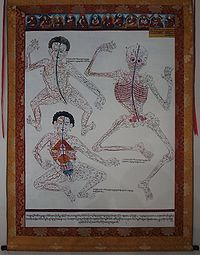
Back བོད་སྨན། Tibetan Medicina tradicional tibetana Catalan Tibetische Medizin German Tibeta medicino Esperanto Medicina tradicional tibetana Spanish Tiibeti meditsiin Estonian Médecine traditionnelle tibétaine French सोवा रिग्पा Hindi チベット医学 Japanese ტრადიციული ტიბეტური მედიცინა Georgian

| Part of a series on |
| Alternative medicine |
|---|
 |
Sowa Rigpa medicine, "Science of healing", "Science of awareness or nourishment" also known as Traditional Tibetan medicine (Tibetan: བོད་ཀྱི་གསོ་བ་རིག་པ་, Wylie: bod kyi gso ba rig pa), is a centuries-old traditional medical system that employs a complex approach to diagnosis, incorporating techniques such as Venesection, Moxibustion, Compression Therapy, Medicinal Bathing, massage and pharmacology that relies on a complex formulary of multi-ingredient drugs that use herbs, minerals, metals, and animal products.[1][2][3]
The Tibetan medical system is based upon indigenous health practices[citation needed] and Tibetan Buddhist literature (for example Abhidharma and Vajrayāna tantras). In addition to the Tibetan areas of China, the areas in which Tibetan medicine has spread include the Ladakh and Sikkim regions of northern India, the western and northern parts of Nepal and the entire territory of Bhutan. China's Inner Mongolia, Xinjiang and the Mongolian-populated areas in the northeast have historical been greatly influences of Tibetan medicine. The traditional medicine of Mongolia and the Buryat and Tuva regions of the Russian Federation, as well as the Republic of Kalmykia, located in the Volga River basin, is also predominantly Tibetan medicine. It embraces the traditional Buddhist belief that all illness ultimately results from the three poisons: delusion, greed and aversion. Tibetan medicine follows the Buddha's Four Noble Truths which apply medical diagnostic logic to suffering.[4][5]
- ^ "National Institute of Showa Rigpa". 2021.
- ^ Kloos, Stephan; Madhavan, Harilal; Tidwell, Tawni; Blaikie, Calum; Cuomu, Mingji (2020). "The transnational Sowa Rigpa industry in Asia: New perspectives on an emerging economy". Social Science & Medicine. 245: 112617. PMC 6983943. PMID 31739144.
- ^ Saxer, Martin (2013). Manufacturing Tibetan medicine: the creation of an industry and the moral economy of Tibetanness. Epistemologies of healing. New York: Berghahn books. ISBN 978-0-85745-772-1.
- ^ Gyamtso, Sangye (April 2005). "Intro card". Tibetan Medicine Cards: Illustrations and Text from the Blue Beryl Treatise of Sangye Gyamtso (1653-1705). Pomegranate Communications. p. 32. ISBN 978-0764917615.
- ^ Kala, C.P. (2005) Health traditions of Buddhist community and role of amchis in trans-Himalayan region of India. Current Science, 89 (8): 1331-1338.